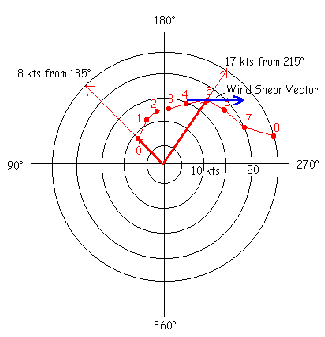 Click for a larger
image
Click for a larger
imageVERTICAL WIND SHEAR, HODOGRAPHS AND TORNADOES
"Better understanding of tornadoes and improved methods for predicting them should grow out of better understanding of the origins of storm rotation. Most tornadic storms rotate cyclonically, but a few rotate anticyclonically. Robert Davies- Jones indicates that the difference is tightly related to the vertical shear of ambient winds relative to the motion vector of the storm. When the vertical shear of the environmental wind is large, updrafts rotate cyclonically and downdrafts anticyclonically when the storm-relative winds veer with height in the lowest 3 km."
Dr. Peter S. Ray, NSSL, 1983
We have already mentioned the importance of winds changing their velocities with height. Veering is important for setting the stage for severe weather. As winds change, they also allow for rotation in the storm updraft (mesocyclone). Varying strengths and configurations of the vertical wind profile and resulting shear determine the nature of the storms that form, whether they are single cells, multicells or supercells.
An interesting tool used for looking at wind shear is the hodograph. The hodograph plots out the wind speed and direction at various heights and overlays them on one chart. At each point labeled by a number representing the height above ground level, the distance between that point and the origin indicates the speed. If you were to draw an arrow pointing from the origin to the point, that would give you the direction whence the wind comes. Assuming that the top of the page is labeled 180°, an arrow pointing up would be from the south (pointing to the label 180°) and an arrow pointing to the right would indicate a westerly wind (pointing to a label of 270°). (See Figure 2.) As in the hodographs on the following page, each level can be plotted and the dots connected. This traces the shearing with height. A line tangent to the curve represents the wind shear vector. Both the wind and the shear vector may change with height, either veering or backing.
Small Shear - In a small wind shear environment, the downdraft gust front will spread out in all directions until the updraft is essentially cut off from the storm. Therefore, a short-lived cell is expected in a non-shear environment.
Moderate Shear - A developing cell will still produce outflow, but this time, cells that grow in response to convergence along the gust front will now move downshear, moving with the mid-level winds. This will allow them to feed on the moist inflow ahead of the gust front. The cell motion and the speed of the gust front may be the same, leading to a continual redevelopment of new cells.
Strong Shear - Rotation now occurs through the tilting of horizontal vorticity inherent in the sheared environment. If this shear exists to the middle levels of the storm (4 - 6 km), then a vertical pressure gradient is induced increasing the updraft strength. This also promotes propagation that varies from the mean wind. Low pressure may develop on both sides of the updraft (known as mesolows) which force the storm to split. Whereas a unidirectional shear causes equal splitting (one to the left and one to the right), curved shear favors the right storm which contains the cyclonically rotating updraft. The lowest 1 - 2 km environment has the most influence on the nature of the storm, and therefore since the climatological environment favors the clockwise turning hodograph, the majority of severe storms rotate cyclonically.
Hodographs demonstrating the relationship between wind shear, wind direction, and storm motion for (A,B) unidirectional and (C,D) curved shear profiles. Heights are in kilometers. Thin solid vector (blue) depict ground-relative wind directions at three heights. Thin dashed vectors (green) depict ground-relative storm motions for left-moving (L) and right-moving (R) supercells. Thick vectors (red) point in the direction of the wind shear vector at the given heights.
Updraft evolution in weak and strong wind shear conditions for unidirectional and clockwise-curved wind shear profiles. Hodographs on the left define the wind shear type;0, 2.5 and 5 km levels are indicated. Large and small circles represent relatively strong and weak updraft, respectively; the path of each updraft cell is indicated by a dotted line. Updraft structure is depicted at the early and mature phases of each storm; surface gust front (barbed lines) are included at the mature phase. L is the approximate position of significant mid-level mesolow features. The direction of the updraft rotation (if any) is indicated by arrows.